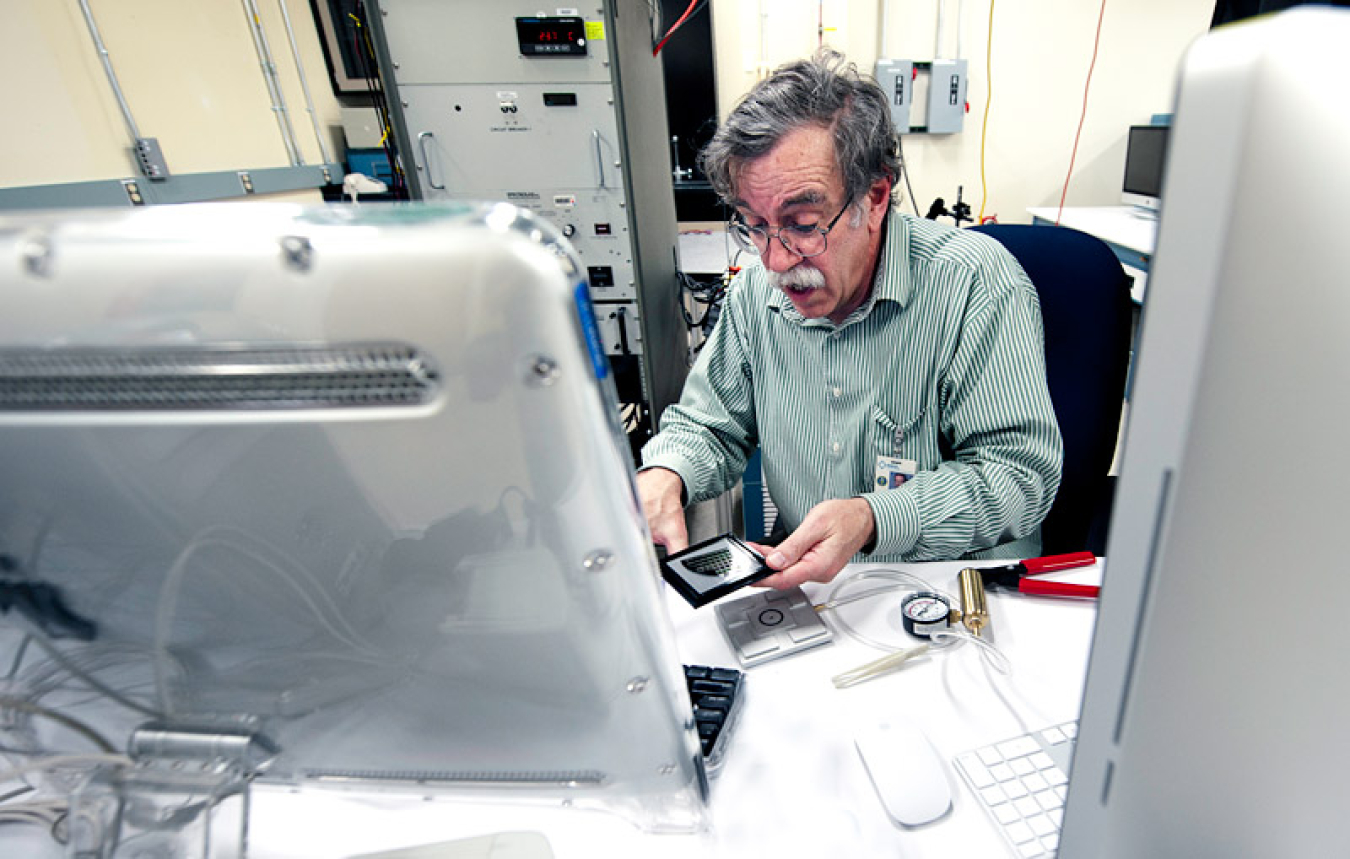
NREL Principal Engineer Keith Emery prepares to load three-junction concentrator cells into NREL's High-Intensity Pulse Solar Simulator to test for efficiency. | Department of Energy Photo | Courtesy of National Renewable Energy Laboratory | Photo by Dennis Schroeder | Public Domain |
"Records are made to be broken." It's become a common refrain in sports after a cherished milestone has been surpassed. The idea need not be confined to home runs, 3-point shots or race times. It applies just as well to scientific and technical accomplishments -- as solar start-ups Alta Devices and Solar Junction can attest.
Experts at the National Renewable Energy Laboratory (NREL) have confirmed that the companies – both current participants in NREL’s PV Incubator Program -- set new world records for their respective technologies:
- Alta Devices, Santa Clara, California – Alta Devices single-junction thin-film Gallium Arsenide (GaAs) photovoltaic technology recently achieved an NREL-confirmed world record 28.2% conversion efficiency. The company utilizes an epitaxial lift-off technique pioneered by UC Berkeley’s Eli Yablonovitch that allows Alta to produce flexible layers of GaAs with a thickness of only one micron. Eventually, Alta thinks that it will be able to build its modules at a cost of around $0.50 per watt. President and CEO Chris Norris recently credited the SunShot Initiative’s aggressive cost targets with helping spur the spirit of innovation at his own company: “The goal of achieving the $1 per installed watt target, set by the Department of Energy, has energized our entire company."
- Solar Junction, San Jose, California – Concentrated photovoltaic (CPV) manufacturer Solar Junction’s multi-junction solar cell recently achieved an NREL-confirmed world record 43.5% conversion efficiency, easily surpassing the previous record of 42.3%. Solar Junction’s multi-junction cells employ multiple semiconductor layers in order to absorb more wavelengths of sunlight, allowing for increased efficiency. The cell technology relies on inexpensive lenses to magnify the amount of sunlight striking each of Solar Junction’s 5.5 x 5.5 mm cells by a factor of 400 to 1000 suns, making electricity from sunlight cheaper by reducing the need for exotic cell materials.
As I’ve discussed in my last few posts about PrimeStar Solar, Abound Solar, and SoloPower, the Department’s Photovoltaic (PV) Technology Incubator is wisely investing taxpayer dollars and the time and expertise of the dedicated engineers and scientists at the National Renewable Energy Lab (NREL) to support technologies that offer pathways to the dramatic cost reductions at the heart of the SunShot Initiative.
The efficiency records set by PV Incubator participants have a profound impact on cost and mean more than calling the folks at Guinness World Records. Greater efficiencies allow for more of the sunlight that strikes the surface of a PV module to be converted into electricity. More efficient modules, in turn, lead to smaller physical footprints for solar power generating facilities – because fewer modules generate the same amount of electricity – which means lower total costs for getting new solar energy on the grid, often called balance-of-systems costs.
Balance-of-system costs account not only for the cost of the solar panels, but also things like land and labor as well as key system components like the racks, cables and inverters. These costs currently account for a significant percentage of the total cost of solar power. Because fewer modules are needed, less land needs to be purchased or leased and fewer racks, inverters, and lines of cable need to be included in a solar system, reducing the cost of solar energy. Moreover, in locations where the physical footprint of solar arrays are limited by space constraints -- rooftops or dense urban areas -- efficient cells ensure that as much energy as possible is captured within the restricted space available, making solar power a more economical option.
Innovations like these and others supported by the Energy Department are pushing the boundaries of energy efficient and renewable technologies, setting new records and ensuring that America is well positioned to win the clean energy future. Both Solar Junction and Alta Devices have maximized their time with the PV Incubator, pursuing solar technologies with the goal of making low cost solar electricity without subsidy by the end of the decade a reality.